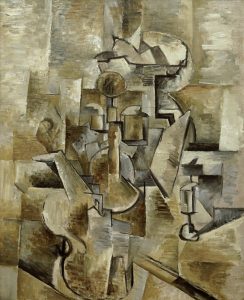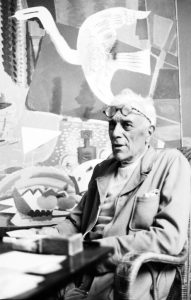Georges Braque was a French artist known for his cubist paintings and the development of collage techniques. He worked with Pablo Picasso breaking the traditional rules of the use of perspective in painting.

Image source: https://en.wikipedia.org/wiki/File:Violin_and_Candlestick.jpg
Georges Braque was a 20th-century French painter who invented Cubism with Pablo Picasso. Braque used the styles of Fauvism, Impressionism, and collage, and also staged the drawings for the Ballet Russes. Throughout his career, his style changed to portray dark subjects during the war and lighter, freer themes in between. He has never strayed far from Cubism. On August 31, 1963, Braque died in Paris.
Early life
Growing up in the port city of Le Havre, France, the young Georges Braque trained as a house painter and decorator like his father and grandfather. Braque studied in the evenings at the Ecole des Beaux-Arts in Le Havre as a teenager. After an apprenticeship with a decorator, he obtained a certificate to practice the trade in 1902.

In 1903, Braque enrolled at the Academie Humbert in Paris. He painted there for two years and become acquainted with the avant-garde painters Marie Laurencin and Francis Picabia. Braque’s early paintings are in the classic impressionist style. Things changed in 1905 when he began to associate with Henri Matisse.
Fauvism period

Braque’s early works were impressionist, later influenced by the works of the art group the “Fauves” (Beasts) in 1905, he adopted a Fauvist style. The Fauves, including Henri Matisse and André Derain, used bright colors to represent an emotional response. Braque also worked with artists Raoul Dufy and Othon Friesz, both born like him in Le Havre, together with whom he developed a slightly more subdued Fauvist style. In May 1907, he successfully exhibited works of the Fauve style at the Salon des Indépendants and in the same year, his style began to evolve thanks to the influence of Paul Cézanne, whose works were first exhibited in Paris in a large-scale retrospective, similar to a museum, in September 1907. This retrospective at the Salon d’Automne strongly influenced the avant-garde artists of Paris, leading to the advent of Cubism.
Cubism
Braque’s paintings of 1908–1912 highlighted his interest in geometry and simultaneous perspective, he conducted a study on the effects of light and perspective also studying the technical means used by painters to represent them. In his village scenes, Braque often reduced an architectural structure to a cube-like geometric form, making its shape appear both flat and three-dimensional by fragmenting the image as shown in the Houses at l’Estaque painting.

Beginning in 1909, Braque began working with Pablo Picasso who had developed a similar proto-Cubist style of painting. At the time, Picasso was influenced by Gauguin, Cézanne, African masks, and Iberian sculpture while Braque was interested in developing Cézanne’s ideas on multiple perspectives. Braque’s main subject is ordinary objects. While Braque celebrates contemplation, Picasso celebrates animation.
Style analysis
Braque believed that an artist experienced beauty “… in terms of volume, line, mass, weight, and through that beauty [he] interpret[s] [his] subjective impression…” He described “objects shattered into fragments… [as] a way to get closer to the object… Fragmentation helped me to establish space and movement in space”. He adopted a monochromatic and neutral color palette convinced that it would emphasize the subject.

Image source:https://picryl.com/media/georges-braques-interview-d8479a
Braque explained that he “… began to focus on still-lifes because in the still-life you have a tactile space, I could almost say a manual space… This responsed to the desire I have always had to touch things and not just to see them… In the tactile space, we measure the distance that separates us from the object, while in the visual space we measure the distance that separates things from each other. This is what bought me, a long time ago, from landscape to still-life” A still life was even more accessible, about perspective, than landscape, and allowed the artist to see the multiple perspectives of the object.
Info sources: https://www.biography.com/artist/georges-braque http://www.georgesbraque.org/ https://www.thoughtco.com/georges-braque-4689083 https://www.theartstory.org/artist/braque-georges/
